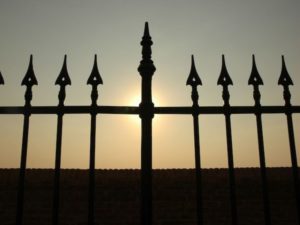You have no items in your cart. Want to get some nice things?
Go shopping
Soon after the ball atop the Times tower officially brought in 2005, workers in Central Park busily prepared the enormous conceptual art project by the artists Christo and Jeanne-Claude. For fifteen years they had been trying to create The Gates, the project’s name an allusion to the park’s original formal entrances carved into the perimeter wall: Women’s Gate, Children’s Gate, Strangers’ Gate, Warriors’ gate, etc.
Thousands of “portals” were planned along the walkways, each waving with saffron fabric. At last New York City had permitted the installation on the strict conditions that it would not be permanent nor harm Central Park in any way. Immediately the project was attacked by some park lovers as antithetical to the Greensward Plan since the park was meant for neither entertainment nor amusement. Bike riders condemned it as a safety hazard for limiting space on the walkways, and a few birders ruffled owing to the disruption the gates might cause Pale Male’s hunting grounds. The park would not profit financially except from the sale of sweatshirts and hats, but hotels and restaurants capitalized creatively on the expected boom when tourism was only recently recovering from 9/11. One hotel with a park view provided binoculars to each guest, while a restaurant served mussels in a saffron cream sauce.
Financed entirely by the artists, the installation would cost an estimated $21 million, which outraged some people: How many hospital wings or crumbling classrooms or struggling families could be aided by such a sum spent for something so impractical, temporary, and indulgent? Though restrictions on entertainment in the park had been tossed out long ago and the world’s most adaptable red-tail hawk could pluck his next squirrel or pigeon from the tree-tops and we weren’t really supposed to cycle on the walkways anyway, I dreaded the huge crowds the event would bring into the park. Besides, I begrudged Christo’s art since the late summer of 1985; with sand-colored canvas, he wrapped Pont Neuf, the oldest bridge crossing the Seine, just when I saw Paris for the first time except in my dreams. Of all the bridges over the river, Pont Neuf was the one I least wanted to see under wraps.
But my girlfriend with whom I was traveling on her way to see family in Munich had often visited Paris and enjoyed the spectacle.
“Ach, deez alt bridge,” she said disapprovingly. “Unt now,” and her eyebrows lifted, “zee bridge is made new, ja?”
For weeks the park teemed with volunteers receiving instructions from people scooting from group to group in golf carts, cluttering walkways and eating in crowded, boisterous shifts at the Boathouse. Press photographers and film crews were everywhere. Christo and Jeanne-Claude surveyed the process on a slab of rock overlooking Wollman Rink; they appeared thrilled, thin, interesting, wrinkled, Jeanne-Claude’s hair bright orange and Christo’s eyes so lively.
And finally on a chilly February 12 beneath a bright sky during a photo-op with Mayor Bloomberg, Christo and Jeanne-Claude unfurled the first gate: Across two saffron-colored poles each sixteen feet high and straddling the walkway was another pole from which unfurled saffron-colored nylon fabric that hung or, ideally, fluttered above us. Throughout the park for the next few hours, spaced twelve feet apart, 7,502 more “gates” were unfurled, varying in width from five feet six inches to eighteen feet wide and covering twenty-three miles of park walkways with 1,076,391 square feet of saffron fabric.
There were gates at all the park’s entrances, around Sheep Meadow, down the promenade, encircling Bethesda Terrace, the Great Lawn, the Harlem Meer and the Reservoir, gate after saffron gate winding along every walkway except through the Ramble and the North Woods. Gates led to every tunnel and waited at the other end, crossed Gapstow Bridge and lined the Pond, marched through the zoo, behind the museum, even reflecting in the museum’s back windows while young volunteers handed out two-inch squares of salmon-colored fabric as souvenirs. But soon it all seemed repetitive after the first three thousand and crowds overwhelmed The Gates. Thousands of visitors posing for photographs caused bottlenecks along the walkways, international film crews narrowed the paths even more, and one young man videoed the event while weaving through the gates on roller blades. I headed home and didn’t think much more about it.
For the next week I avoided the park, but one Sunday morning a light snow began to fall, turning heavier in the next hour until two inches coated the fire escape railings outside the window. The sooner we arrived, the more the park would be only ours, so we bundled in boots and jackets, mittens, scarves and woolly caps until my children Lily and Skylar resembled little gnomes. With birdseed and peanuts for squirrels, we headed into the snowfall on our old sled with steel, red runners and “Paris Champion Fastback” in faded letters along the wooden slats.
Even a Midtown workday turns quiet during a snowfall, muffled and slow, but no place is more hushed than Central Park where the snow doesn’t quickly turn to dirty slush. Having forgotten about The Gates I understood everything when we arrived; in the white park a ribbon colored like the sun wound along the walkways. It dipped and gently curved, rose and then descended again, motionless and glowing in the unblemished snow. My children were dazzled.
“Daddy,” Skylar, said, amazed, “how beautiful.”
“Who did this?” Lily asked, hushed and enthralled.
Along the West Drive as we trudged the saffron-ribbon shore of the white lake, a black limousine ground the snow beneath its slow-turning tires. The back window was down, and two pale, wrinkled faces smiled out into the cold air: an old man, his bright eyes beaming, and a woman with hair only a shade darker than the gates.




